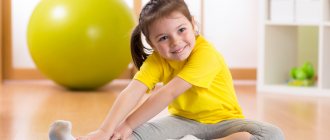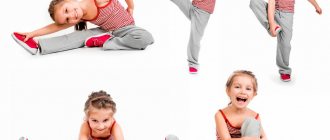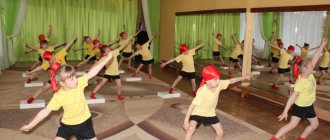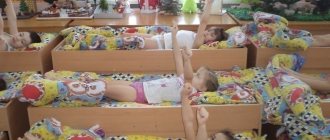Methods used
By the age of three or four, children have almost mastered the entire alphabet and learned to construct sentences to express their thoughts. But some people still have trouble coordinating words (for example, “one ball”). Therefore, in any case, all exercises should be clearly and understandably explained to adults. This will help get rid of speech errors.
Important! The teacher must clearly state all instructions. To make it more interesting, it is better to use rhymes and riddles.
Exercises with rhymes
Visual techniques
The image helps children better understand the world around them. That is why it is best to accompany all classes:
- pictures of animals, cartoon characters;
- step-by-step hand-drawn instructions;
- demonstration of the exercise by the teacher.
Practical technique
This method involves independent activity of children. For example, drawing, making crafts from different materials, etc. This type of activity is very important, because with the help of it, imagination and fine motor skills develop, and children learn to fantasize.
Gaming technique
He is usually accompanied by music. It helps you feel the pace and rhythm of the exercise. Musical tones help you understand when you need to change the nature of your movements. For example, calm music encourages moderate walking, while cheerful and lively music encourages running and jumping. In addition, it increases the discipline, efficiency, and attentiveness of children.
When to enroll your child in the swimming section - when to sign up?
Morning exercises in the middle group (according to the Federal State Educational Standard)
Morning gymnastics in the middle group (according to the Federal State Educational Standard)
Author: Svetlana Vladimirovna Grebenyuk, teacher Place of work: MBDOU “Kindergarten of a combined type “Masterok”, Abakan Description of the material: I offer you a scenario for morning exercises. I thought for a long time about how to combine exercises with the requirements of the Federal State Educational Standard. And I got it: “basic structure” and “changeable content” (the guys already knew a lot of movements and exercise songs by E. Zheleznova and other authors) Participants: children, teacher, music director. Equipment: flag, box with images of the heroes of the song.
Summary of morning exercises in the middle group “Jolly Guys.”
Goal: creating conditions for healing the body through a set of physical exercises.
Objectives: Educational: - create conditions for the formation of basic motor skills;
— provide conditions for the formation of sustainable interest in morning exercises; — create conditions for the formation of children’s readiness for joint activities; -promote the development of independence and initiative; Developmental: -promote the development of coordination of sensory systems in children; — create conditions to encourage children to engage in speech activity; — promote the development of motor, auditory, and long-term memory in children; — create conditions for the development of distribution and switching of attention; — promote the development of the child’s interaction skills with adults and peers; Educational: - cultivate the ability to listen to each other; - cultivate a sense of satisfaction from participating in collective activities; - create conditions for a joyful mood, give children an emotional charge for the coming day; Progress of morning exercises.
1. Children follow the rhythm of the march, form a circle and stop. 2. Q: Guys! I need 4 assistants. How do we choose them? Possible answers for children: using counters or lots (a set of geometric shapes of two colors). Counting rhymes: A lamb was walking in the meadow, The lamb lost its horns. A hungry wolf walked by, he snapped a lamb with his teeth! Greek rode across the river. The cancer sees the Greek in the river. He put the Greek's hand into the river. Cancer for the hand of the Greek - DAC. A dog walked across the bridge, Four paws, Fifth tail. Two firefighters ran, And they pressed the button - Ding! The teacher, together with the children, selects four people (they form a small circle inside a large one). The teacher gives one of the children a flag. 3. Each assistant offers to perform movements in a circle (the signal for the order is a musical chord and passing the flag to the next one). The assistants also perform movements in their circle. Possible movements: “Fox”, “Heron”, “Geese”, “Bees”, walking on toes, side step, jumping on two legs, jumping with a hop, etc. 4. The teacher takes the flag and all the guys run around circle (with a turn in the other direction) to cheerful music. 5. Q: Now let’s see what song was hidden in our box today. The teacher takes masks out of the box and puts them on the assistants. The guys guess the name: “The hares stood up in order...”. Everyone sings a song to the music
and perform the appropriate movements (when it is the character’s turn, the child goes into the middle of the circle). Verse 1 The hares stood up in order The hares do exercises (jerks with their arms) The cat, too, don’t be lazy - Get ready to exercise. (hands to your shoulders and up, repeat to the rhythm) Chorus: (repeat 2 times) Jump-jump, hands up Jump- jump, hands down (jumping with clapping overhead) Now come on, my friend, pull yourself up, stretch, stretch. (stretch on your tiptoes, arms up) Verse 2 Nearby, a hedgehog is trampling the grass, He wants to exercise with us. (squats, arms forward) We’ll walk with a hedgehog, raise your legs higher. (swing your legs to your arms outstretched forward) Chorus: (repeat 2 times) Top-top, step forward, (step forward) Top-top, step back. (they step back) And now clap your hands The legs are up and standing. (Clapping and half-squatting) Verse 3 The frogs on the water lily Straightened their backs together (arms bent at the elbows, fingers spread and swinging left and right) Put their paws on their sides And sway slightly. (stand, hands on the belt) Chorus: (repeat 2 times) Kach-kach, right, left, Kach-kach, left, right. (leans to the side) This is such a frog (stretch on toes up) Both exercise and fun. (bending forward) 6. Walking in a circle and leaving the hall to the music.
We recommend watching:
Summary of educational activities of the NGO "Physical Culture" for the middle group GCD on physical education in the middle group Summary of GCD on physical education in the middle group using non-traditional forms is improved Summary of physical education classes for children of the middle group
Similar articles:
Morning exercises in the preparatory group in a playful way
How to conduct gymnastics for children 3-4 years old in a preschool educational institution
Any preschool teacher should know some of the features of exercises for 3-4 year olds. They are the basis; without them, morning exercises simply cannot be done.
- Morning exercises in the younger group are carried out strictly before breakfast.
- It consists of exercises that warm up the body and a number of additional restorative ones.
- The lesson should last no longer than 7 minutes, ideally 5 minutes.
- In the warm season, physical education is best done outside, as it will be more useful. In winter, especially in December, exercises should be carried out on the veranda or in a specially equipped room, for example, a games room with mats.
- There are two requirements for the room: the temperature should not exceed 16°C, the room is ventilated before class.
- Children are required to wear sportswear with sneakers and tie up their hair.
- If your child refuses to do the exercises, then you should not force him. But after the lesson you need to ask what was the reason for the refusal.
- If music is turned on while charging, children's interest will increase.
- You should not ask children to strictly adhere to discipline or a clear sequence of movements. Classes should be held in the form of a game, for example, by acting out a skit.
- The mandatory list includes exercises with sports equipment: balls, flags, ribbons, etc.
- The optimal number of repetitions of the task is 5. Practicing one set of exercises is limited to 10 days.
Morning exercises in kindergarten - exercises for exercise
Important! The teacher should not limit himself to knowledge of the general principles of children’s gymnastics in preschool educational institutions. It is recommended to know the classification of exercises, the content of the exercise itself, techniques for preparation and its successful implementation.
Charging outdoors
Types of exercises:
- general developmental (running, jumping, etc.);
- exercises with elements of a storyline (exercises based on a fairy tale, skit, etc.);
- a set of 3-4 exercises (for example, the “Shaggy Dog” complex, “Train”, etc.);
- alternating running and jumping exercises;
- tasks with attributes (children's expander, trampoline, etc.);
- obstacle course.
Important! The exercises during the obstacle course should not be too difficult so that every student can repeat them.
The main stages of any charging:
- warm-up (walking);
- exercises for various muscle groups;
- leisurely running;
- moderate walking (you can add outdoor play).
Exercises in kindergarten after sleep: with words
The exercises are carried out for seven minutes, the teacher shows the exercises and explains them.
- Sipping. Children lie on their backs, arms along the body, legs together. You need to stretch, stretching your spine.
- Let's draw a rainbow. The starting position is the same. Children need to first raise their right leg, drawing a semicircle in the air, without bending their knees. Repeat the same steps with the left leg.
- Thunder. Previous starting position. Pull your legs to your chest and clasp them with both hands. Return to starting position.
- Ships. Children lie on their stomachs, hands under the chin, legs together. You need to rise up and arch your back. Extend your arms straight forward and swing.
Cat, open your eyes
The teacher reads poems and the children do exercises.
Two in one
If you are bored with just exercises, and your baby asks you to play with him, do an exercise-game. Such warm-ups begin as physical education in verse, and end with a game element. It is better when several children participate in the exercise-game. When planning a children's party, you can also use such game physical education minutes in the program. Kroshka and Masha The little mouse is called Kroshka (they squat down and squeak like mice). The little mouse is hiding here (we point our finger at ourselves). The mouse runs out at night for a walk (we run in different directions), begins to jump noisily and laugh (we run, jump, laugh). But, as soon as the cat suddenly says “Meow” (everyone freezes in place), the Mouse freezes - everything around is quiet... Imagine, our Little One is Afraid of the Cat Masha! (everyone scatters in different directions, and the leader plays the role of a cat and, meowing, catches up with the “mice”) Heron , Bear walks with club feet, spreading his paws strongly (we depict how the bear walks, waddling), Squirrel jumps through the forest - Red-tailed princess (bounce) . A turtle walks into the field very smoothly and without fear (we get on all fours and move slowly). The horse is trotting and will give you and me a ride (we run, kicking our legs like a horse). Well, the heron, the miracle bird, the long-legged maiden, stood like a candle on one leg all evening! (Everyone tucks one leg in and stands in such a way that who can stand it as long as possible. The leader counts: one, two, three, etc., waiting for the losers. Whoever lasted the longest while standing on one leg won). Be active in activities with children, show your interest so that children are involved in fun physical education with joy. Show all the movements clearly, help the kids depict them correctly, give enough time for each new exercise. If the kids liked, for example, a line from a poem where they need to jump, give them the opportunity to do this longer. Repeat the exercises that the children liked, and replace the texts that the children did not like with others.
Children doing exercises, senior group: movements
- Introductory part. It requires a warm-up, so exercise should begin with alternating running and walking. Diversify all this by moving in space; moving in one place quickly gets boring for the kids.
- Main part. It includes important exercises that develop muscles, spatial orientation and joint mobility.
- The final part. Complete the exercise with moderate walking.
Example of morning exercises:
Warm-up
- Children walk at a normal pace behind each other in a circle or column.
- Running in a straight line or with obstacles.
- Walking on your heels, toes, and the inside and back of your feet.
- Walking, in which the position of the hands alternately changes, walking with raising the knees.
- Running with stops on command (voice or clap).
Main part
- Exercise No. 1: Place your hands behind your back, feet shoulder-width apart. Children take a breath, bend over and exhale.
- Exercise No. 2: Children place their hands on their belts and rotate their torso to the right and left.
- Exercise No. 3: The guys raise their hands up, stand on their toes, and reach for the sky with their fingers. Then they lower themselves onto their feet and lower their arms.
- Exercise #4: Lie on your back. Turn onto your stomach immediately through the left, then through the right side.
- Exercise No. 5: Hold your hands in front of your chest. Jump like bunnies in place, then around an imaginary bush.
Final part
Walking around the hall at a moderate pace.
Where to look for fresh charging ideas
In addition to ready-made exercises in verse, you can use ordinary children's poems for home physical education. Take appropriate texts and act out what they say as you go. This will help you out when you find yourself with a child in nature or with your grandmother in a village where there is no access to the Internet. Here's how you can turn nursery rhymes into exercises: Giraffe (Samuel Marshak) Picking flowers is easy and simple For small children, (we sit on our haunches and pretend to pick flowers) But for those who are so tall, It’s not easy to pick a flower (we stand with our legs straight, socks, and “picking flowers”, bending over but not bending the knees). Boat (Agniya Barto) Sailor's hat, Rope in hand (we march in place), I'm pulling the boat Along a fast river (we start moving as if we're pulling a boat), And frogs are jumping at my heels (we crouch and jump) And they ask me: - Take it for a ride, captain! (we wave our hand). Elephant (Agniya Barto) It's time to sleep! The bull fell asleep (we put our palms under one cheek, as if we were sleeping), lay down in the box on his side. The sleepy bear lay down in bed (we place our palms under the other cheek), Only the elephant does not want to sleep (we get down on all fours). Sleep shakes his head (we stand on all fours and shake our heads), He sends his bow to the elephant (we bow).
Morning exercises set of exercises
For children in kindergarten, exercises are carried out on the street or in a music room, usually in a playful way. The duration of morning exercises should be no more than five minutes for the junior and middle groups, no more than ten minutes for the senior and no more than fifteen minutes for the preparatory group. You should not resort to complex exercises; exercise should be fun.
- While charging, upbeat music should sound, which will help set the kids in the right mood.
- Exercises should be interesting. You can show how animals move or tell a fascinating story about how a hedgehog visited a bear through obstacles.
- You can accompany the exercises with funny songs and rhymes.
- Pay attention to the quality of the exercises performed. In order for children to strive to do everything right, they need to be praised more often.
Features of charging for different groups:
- Junior group - four developmental exercises, running, walking. Each exercise is repeated four times. Duration: five minutes. Additional equipment: cubes, hoop houses, plumes, rattles. It is better to conduct exercises in the form of a fairy tale or ask children to perform the exercise like a cat or a bunny.
- Middle group - five general developmental exercises, repeated five or six times. Walking is complemented by exercise. You can change its tempo by clapping. Duration: six minutes. Equipment: hoops, balls, ribbons.
- Senior group - six general developmental exercises, children learn how to jump and move to the music. Charging lasts ten minutes. Equipment: gymnastic stick, pigtail cord, ball.
- Preparatory group – six general developmental exercises repeated six to eight times. Duration – fifteen minutes. The child is required to perform quality exercises. Equipment: children's dumbbells, inflatable balls, jump ropes, wall bars.





